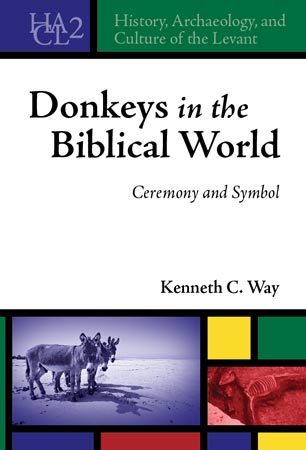
! It can tell you everything you never knew you needed to know about donkeys in the biblical world. It's actually quite a technical read since it began long ago as my dissertation project at Hebrew Union College (Cincinnati, OH). So it may not be the best book for, say, small group Bible studies or local book clubs. But if you want a dose of ancient Near Eastern and archaeological analysis, then this one is just for you. Since I hate to reinvent the wheel, I will quote here my description of the book as it was written on the back cover:
"In this volume, Kenneth Way explores the role of donkeys in the symbolism and ceremonies of the biblical world. His study stands alone in providing a comprehensive examination of donkeys in ancient Near Eastern texts, the archaeological record, and the Hebrew Bible. Way demonstrates that donkeys held a distinct status in the beliefs and rituals of the ancient Near East and especially Canaan-Israel.
The focus on ceremony and symbol encompasses social and religious thoughts and practices that are reflected in ancient texts and material culture relating to the donkey. Ceremonial considerations include matters of sacrifice, treaty ratification, consumption, death, burial, "scapegoat" rituals, and foundation deposits; symbolic considerations include matters of characterization, association, function, behavior, and iconographic depiction. However, the distinction between ceremony and symbol is not strict. In many cases, these two categories are symbiotic.
The need for this study on donkeys is very apparent in the disciplines that study the biblical world. There is not a single monograph or article that treats this subject comprehensively. Philologists have discussed the meaning of the Amorite phrase "to kill a jackass," and archaeologists have discussed the phenomenon of equid burials. But until now, neither philologists nor archaeologists have attempted to pull together all the ceremonial and symbolic data on donkeys from burials, ancient Near Eastern texts, and the Hebrew Bible. Way’s study fills this void."
Also, from the foreword there is a well-stated description of the book written by my advisor and first reader, Professor Nili Fox:
"In this study Kenneth Way examines the large and diverse corpus of texts, comprised of Sumerian, Akkadian, Egyptian, Hittite, Ugaritic, Aramaic, and Hebrew sources that in some way deal with the ceremonial and symbolic significance of donkeys. Simultaneously, he scrutinizes the archaeological records of varied equid burials from dozens of sites in Egypt, Israel-Palestine, Syria, and Iraq, including the recently discovered monumental burial complex at Umm el-Marra. The author then synthesizes and explicates the integrated textual and archaeological material attesting to the special status of the donkey in the cultic spheres of the region. The latter is especially key in elucidating certain literary texts and rituals in the Bible that seem to contain vestigial forms of earlier practices, as the Shechem traditions recounting Jacob’s sons’ dealings with the clan of Hamor and the Exodus law stipulating the redemption of the first-born ass. Importantly, Kenneth Way does not feel compelled to arrive at monolithic conclusions in his study. Rather, his methods underscore the need to contextualize evidence so that even what appears to belong to a single category, in this case religious rites, may be variegated, requiring careful attention to distinguishing details rather than identifying general commonalities."
 ºÚÝ®ÊÓƵ
ºÚÝ®ÊÓƵ
.jpg)


